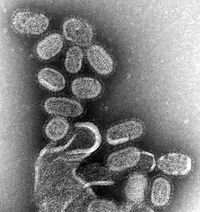
Photo from wikipedia
OBJECTIVE To investigate the burden for Health Care Workers (HCWs) who suffer from Occupational-Related Adverse Events (ORAEs) while working in contaminated areas in a specialized hospital for Novel Coronavirus Pneumonia,… Click to show full abstract
OBJECTIVE To investigate the burden for Health Care Workers (HCWs) who suffer from Occupational-Related Adverse Events (ORAEs) while working in contaminated areas in a specialized hospital for Novel Coronavirus Pneumonia, to explore related risk factors, and to evaluate the effectiveness of Bundled interventions. In addition, to provide scientific evidence regarding the reduction of risks concerning ORAEs and occupational exposure events. METHODS The study was completed on a special team of 138 HCWs assembled for a specialized hospital for Novel Coronavirus Pneumonia in Wuhan, dated from February 16th to March 26th, 2020. The incidence of occupational exposure was determined by data reported from the hospital, whilst the prevalence of ORAEs was derived from questionnaire results. The relation coefficients of ORAEs and the variable potential risk factors are analyzed by logistic regression. After the risk factors are identified, targeted organized intervention was implemented and Chi-square tests were performed to compare the incidence of occupational exposure and the prevalence of ORAEs in contaminated areas before and after the interventions. RESULTS Ninety one out of 138 (65.94%) had reported ORAEs with 300 (27.96%) cases of ORAEs being recorded in a total of 1073 entries into contaminated areas. The prevalence of different ORAEs include 205 tenderness (24.73%), 182 headache/dizziness (21.95%), 138 dyspnoea (16.65%), 130 blurred vision (15.68%) and 95 nausea/vomiting (11.46%). Personal Protective Equipment (PPE) is significantly associated with ORAEs in contaminated areas (P<0.05). Among non-PPE-related factors, insomnia is associated with the majority of ORAEs in contaminated areas. Significant differences were achieved after organized interventions in the incidence of occupational exposure of HCW (χ2=39.07, P<0.001) and the prevalence of ORAEs in contaminated areas (χ2=22.95, P<0.001). CONCLUSION During the epidemic period of novel severe respiratory infectious disease, the burden of the ORAEs in contaminated areas and the risk of occupational exposure of HCWs are relatively high. In-time, comprehensive and multi-level bundled interventions may help to decrease the risk of both ORAEs and occupational exposure.
Journal Title: Disaster medicine and public health preparedness
Year Published: 2021
Link to full text (if available)
Share on Social Media: Sign Up to like & get
recommendations!